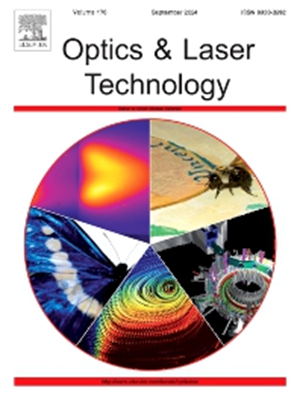Recognition and phenotypic detection of maize stem and leaf at seedling stage based on 3D reconstruction technique
IF 4.6
2区 物理与天体物理
Q1 OPTICS
引用次数: 0
Abstract
As one of the major global food crops, rapid detection of seedling maize phenotypic traits is important for maize cultivation, management and variety selection. Due to the lack of a systematic approach for the morphological-physiological phenotypic profiling of maize growth stages, it is urgent to overcome the challenges of multi-view 3D reconstruction and phenotypic detection in seedling maize. In this paper, recognition and phenotypic detection of maize stem and leaf at seedling stage was proposed based on 3D reconstruction technology. First, a maize heterogeneous data collection system was constructed using three Kinect v2 sensors to acquire 810 sets of color images and depth data for the maize plant. Second, maize plant data were obtained through filtering, radius outlier removal, and Euclidean distance segmentation algorithms. Third, an improved random sample consensus − trimmed iterative closest point (RANSAC-TrICP) algorithm was employed for 3D registration of multi-view maize point clouds, achieving an average registration error of 0.0030. On this basis, a maize stem and leaf recognition method was established, which integrated eigenvalue decomposition and normal analysis techniques, achieving an accuracy of 0.9897. In addition, the density-based spatial clustering of applications with noise (DBSCAN) clustering algorithm was used to identify individual leaves, with an accuracy of 0.9516. Finally, 3D image processing and mathematical statistical algorithms were used to establish the plant height algorithm based on3D Euclidean distance, the leaf length algorithm based on fitting the single-leaf axis, the canopy width algorithm based on the external rectangle, and the stem thickness algorithm based on the least-squares method of fitting a circle. The results showed that the R2 values for plant height, canopy width, leaf length, and stem thickness, were 0.9723, 0.9788, 0.9796, and 0.9876, respectively, comparing the calculated values with the measured values. This method effectively addressed the challenges of high-throughput phenotypic detection technology in monitoring maize growth state, providing a quantitative basis for the scientific regulation of phenotypic traits in maize cultivation, management, and breeding.
求助全文
约1分钟内获得全文
求助全文
来源期刊
CiteScore
8.50
自引率
10.00%
发文量
1060
审稿时长
3.4 months
期刊介绍:
Optics & Laser Technology aims to provide a vehicle for the publication of a broad range of high quality research and review papers in those fields of scientific and engineering research appertaining to the development and application of the technology of optics and lasers. Papers describing original work in these areas are submitted to rigorous refereeing prior to acceptance for publication.
The scope of Optics & Laser Technology encompasses, but is not restricted to, the following areas:
•development in all types of lasers
•developments in optoelectronic devices and photonics
•developments in new photonics and optical concepts
•developments in conventional optics, optical instruments and components
•techniques of optical metrology, including interferometry and optical fibre sensors
•LIDAR and other non-contact optical measurement techniques, including optical methods in heat and fluid flow
•applications of lasers to materials processing, optical NDT display (including holography) and optical communication
•research and development in the field of laser safety including studies of hazards resulting from the applications of lasers (laser safety, hazards of laser fume)
•developments in optical computing and optical information processing
•developments in new optical materials
•developments in new optical characterization methods and techniques
•developments in quantum optics
•developments in light assisted micro and nanofabrication methods and techniques
•developments in nanophotonics and biophotonics
•developments in imaging processing and systems

 求助内容:
求助内容: 应助结果提醒方式:
应助结果提醒方式:


